Ear initiation begins in a corn plant at the V5 growth stage (five fully expanded leaves with the leaf collar visible). Plants subjected to environmental and agronomic stress during this critical period can have abnormally shaped ears, damaged kernels, or very few kernels. Stress factors can include drought, temperature extremes, saturated soil, nutrient deficiencies, disease or insect injury, and pesticide applications. The malformations can be a combination of stress factors; however, the type of malformation can help determine the cause and provide information for future management, if possible.
Many times, the malformations are not discovered until harvest. Determining the cause at harvest may be difficult because the causal factor, such as insect feeding, is likely no longer present. Weekly scouting during the growing season can help identify the cause when it is occurring or present. Environmental causes such as drought and hail damage are the result of Mother Nature and unavoidable. Agronomic causes such as pesticide application timing, compaction, and plant population are manageable.
Abnormal Ear and Kernel Damage Descriptions
Pinched Ears
Ear length is usually normal; however, a portion of the ear base may have 50% more rows than the remainder of the ear (Figure 1).1 Kernel row number is determined during the V7 to V10 leaf collar stages with a doubling of the row number occurring about V9.1 Severe stress during this growth period, particularly a late post-emergence application of an ALS (acetolactate synthase) herbicide can cause the kernel row number to be reduced from the point in time of the application. Sulfonylurea herbicide and organophoshate soil insecticide interactions may also be a cause.(1)
Kernel row number at the base of each ear developed normally until an ALS herbicide was applied. The two ears on the right were affected more than the left two ears. This could be a result of the amount of herbicide absorbed by the plant.
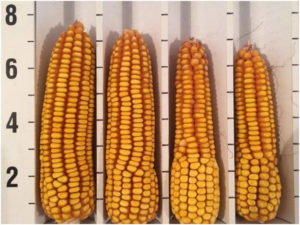
Figure 1. Ears showing reduced kernel row number. Kernel row number at the base of each ear developed normally until an ALS herbicide was applied. The two ears on the right were affected more than the left two ears. This could be a result of the amount of herbicide absorbed by the plant.
Blunt Ear Syndrome
Also referred to as “beer can ears” or ear stunting. Characterized by reduced ear length, normal (for corn product) kernel rows at base of ear, and usually a barren ear tip (Figures 2, 3 and 4). The reduced kernel number suggests a biotic (living) or abiotic (non-living) stress occurred before ear size determination was complete. Possible causes include cold shock, a foliar fertilizer application, or a chemical application during the V8 to V12 (pre-tassel) growth stages of a late post-emergence herbicide (ALS, PGR (plant growth regulator), glufosinate, glyphosate), a fungicide (strobilurin), an insecticide, and spray adjuvants.(2) Research at Purdue University suggests the syndrome can be caused by an application of a nonionic surfactant (NIS) prior to tasseling with or without a foliar fungicide.3,4 The greatest risk for occurrence appears to happen from V12 to V14 growth stages (about one to two weeks before pollination).4 Husks are slender and pointed which restricts silk emergence.
Incomplete Kernel Set
Characterized by ears with few and sporadic kernels. Causes can include uneven crop development, an inadequate supply of pollen during pollen shed and silking, severe drought, high temperatures, herbicide injury, and insect silk clipping (Figures 5, 6 and 7). Additionally, a phosphorus deficiency can interfere with pollination.(1)
Zipper Ears
Characterized by partial or missing kernel rows on the underside of the ear due to kernel abortion (Figures 8 and 9). The missing rows can cause the ear to bend like a banana. The specific cause is unknown; however, suggested theories include drought stress, defoliation after pollination, high plant population, and extensive covering of underside ear silks by upper ear silks that may block fertilization.1 Pesticide misapplication may also be a cause.
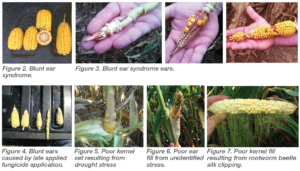
Unfilled Ear Tips or Tip Dieback
Unfilled tips can be caused by poor silk fertilization which results in kernel abortion. Unfertilized ovules and aborted kernels may appear dried up and shrunken (Figure 10). Aborted kernels may have a yellow color (Figure 11).1 Drought, nitrogen deficiency, high temperatures, foliar diseases, and cloudy weather during early kernel development may be potential causes.
Unfilled ear tips can be genetic as some corn products tend to have an unfilled tip. Additionally, ample moisture after pollination can cause the cob to lengthen beyond previously fertilized kernels (Figure 12).
Chaffy Ears
Characterized by ears with shrunken, lightweight kernels that have gaps between the kernels (Figure 13). Ears can be poorly filled. Premature plant death caused by frost, drought, disease, high temperatures, and insects are among the causes. Additionally, high plant population, severe potassium deficiency, and hail damage can be possible causes.(1)
Drought Damaged Ears
Drought damaged ears have characteristics of other abnormal ear types. Tips can be unfilled, row numbers can be reduced, kernel set can be incomplete and scattered, kernels can be light in weight and chaffy, and ear size can range in size from very small (nubbin) to medium depending on when the drought event began. Other causes for nubbin ears can include nitrogen deficiency, and high plant populations.(1)
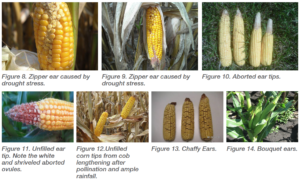
Bouquet Ears
Characterized by several ears appearing on the same node (Figure 14). The cause may be related to heat stress during early ear formation and development (V5 to V15 growth stages) and the misapplication of pesticides (herbicides, fungicides, insecticides) prior to tasseling. Additionally, the apical dominance of the main ear may be lost causing multiple ears to form.(5)
Insect and Mite Injury
Insect (adults or larvae) and mite feeding on silks, kernels, and developing ears can cause ears to have missing kernels, bruised or damaged kernels, malformed ears, and reduced grain quality.
Silk feeding by corn rootworm beetles and Japanese beetles can cause ears to have missing kernels because of unsuccessful ovule fertilization (Figure 7).
Stink bugs pierce through the husk on immature ears and inject a toxin that causes the cob and husk to cease development on the pierced side. The other side continues to grow causing a hooked or banana shaped ear (Figure 15) to form. Exposed kernels from the reduced husk coverage become food for birds, other insects, and are exposed to environmental issues. Piercing through milk-stage ears can cause individual kernels to shrink, be discolored, and have feeding scars.(1)
Direct feeding on corn ears by corn earworm, European corn borer, and Western bean cutworm can cause kernels to be highly damaged or missing (Figure 16).
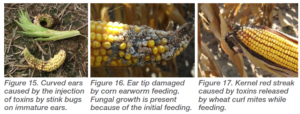
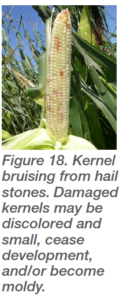
Additionally, because of the damage, individual kernels or parts of the ear may develop kernel or ear rot. Kernel red streak is a reddish discoloration of ear-tip (mostly) kernels caused by the secreted toxin of the wheat curl mite when feeding on the kernels (Figure 17). Coloration can vary by corn product and some corn products may have a genetic characteristic for reddish kernels.
Hail Damage
Hail can cause kernels to be bruised, discolored, missing, and have fungal growth. The amount of injury depends greatly on the state of kernel development at the time of the hail event and the size of the hail stone (Figure 18). Large hail stones can smash immature kernels and break the seed coat which allows the milk to flow onto surrounding kernels. The sugar content of the milk becomes a medium for fungal growth which can damage additional kernels. Hail damaged ears may have a void of kernels where the hail stone hit (Figure 19).
Smut Ears
Smut can be found on any part of the corn plant throughout the growing season. Smut spores can enter corn tissues after injuries from hail, insects, and wind. The smut can completely engulf or partially cover an ear (Figure 20). Smut can also be found on “tassel ears” which are prone to develop on corn tillers (Figure 21).
Clear or Translucent Kernels
Characterized by random kernels with a clear liquid appearing among normal appearing kernels on a normal sized ear (Figure 22). The abnormal kernels collapse during kernel maturation leaving behind a shriveled shell. The syndrome has been attributed to a late glyphosate herbicide application.(1,6)
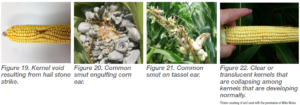
Article Link – Abnormal Corn Ear Development
